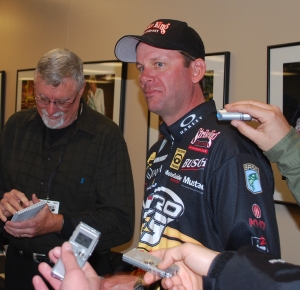Bassmaster Elite Series pro Kevin VanDam is without a doubt the most successful bass tournament angler of all-time.
If you don’t already know the following, consider these facts about the Kalamazoo, Mich. native: he’s the winner of four Bassmaster Classic titles; the owner of seven B.A.S.S. Angler of the Year titles; the winner of 20 B.A.S.S. events; has 96 B.A.S.S. “Top 10” finishes so far in his career; is owner of one FLW Angler of the Year title; and is a tournament pro with more than $5.6 million in combined career earnings.

When Kevin VanDam talks about how to be a better bass angler, it pays to listen closely and take notes. Even if you are a dyed-in-the-wool fly fisherman.
Put simply, KVD is the undisputed king of modern tournament bass angling.
Big deal you say? Yeah it is.
The man is a bona fide bass catching machine no matter where he fishes, the time of year that he is on the water, or what the conditions are like while he is there.
And believe it or not, KVD can teach a fly fisherman plenty about gaining more hook-ups with black bass.
As long as you’re willing to listen to what he (and other bass fishing pros) have to say and then figure out how to transfer that information to the skill set that you need while you are on the water with a fly rod in your hand.
Take, for instance, these tidbits I gleaned from angling writer Steve Price and the story he authored in the April 2010 issue of “Bassmaster” magazine
During that piece, Price queried KVD about whether or not irregular lure movement can be critical in triggering a bass to strike.
KVD’s response is one that both a lure fisherman and a fly fisherman should take to heart:
“Absolutely. Bass are very much keyed to any irregular movements out of their prey, so I either use lures like tubes that have this irregular action built into them, or I add it myself.
“I’m going to jerk it, twitch it, stop it, start it, speed it up, slow it down – all the things I can do that are out of the ordinary. And I do some of them on every cast or flip. When I can combine an irregular action with speed, it’s even better.
“I’ve seen so many times when bass don’t show any interest in a school of baitfish or bluegill unless one shows a weakness, and that’s the one they pick. It’s no different than a lion chasing a wildebeest; the predator is looking for something that offers it an advantage, and bass are very good at using their habitat and the existing conditions to do that.”
So how does that play out for a fly fisherman?
Simple. Don’t get caught up in the motions of making a rhythmic cast, laying your fly into a “bassy” looking area, and then methodically retrieving it back with a steady “strip, strip, strip” motion.
The same retrieve that 99% of all fly anglers seem to fall into by default.
The type of retrieve that a bass looks in the direction of before offering a yawn.
Instead, follow KVD’s advice.
Or my paraphrase of it: let your fly become a sick wildebeest.
Get the fly in tight to the places where a bass might lurk. Get the undivided attention of a big old mama bass as you strip the fly back erratically like a drunken sailor. Bang the fly into objects. Stagger it. Stop it. Start it. Rip it, pause it, and let it fall down. Vary the speed of the retrieve, fast one minute, slow the next, then somewhere in between.
In short, do all that you can to make your fly look like an easy pickings meal that a big predatory bass simply can’t refuse taking a swat at.
Do that once on an outing and you might hook a good bass.
Make that type of attention grabbing, strike triggering retrieve happen often enough and you might have an outstanding day on the water.
Learn how to incorporate such tactics into your arsenal each and every time that you take to the water and maybe one day, you’ll be known as the KVD of fly fishing for bass.
If I don’t beat you to that title first, that is.
Thanks to figuring out how to make my flies look like the sickest of all wildebeest.